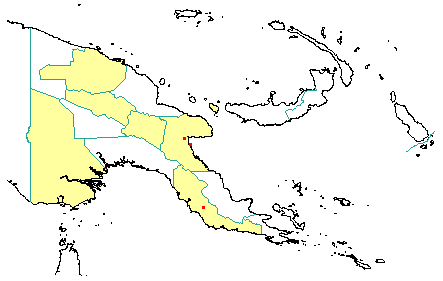
in PNGplants database
PNGTreesKey – Dryadodaphne novoguineensis (Perkins) A.C.Sm. subsp. novoguineensis |
Barry Conn (NSW) & Kipiro Damas (LAE).
Guide to trees of Papua New Guinea
Copyright held by the authors, National Herbarium of New South Wales, and Papua New Guinea National Herbarium
Journal of the Arnold Arboretum Vol. 23: 443 (1942)
Other Literature: W.R. Philipson, Flora Malesiana, Series 1 266 (1986)
Family: Atherospermataceae
Dicotyledon
Timber Group: Minor hardwood
Field Characters: Large canopy tree (20-40 m high, sometimes to 50 m); Bole cylindrical (50-95 cm diam.); straight (bole 20 m long); buttresses often buttresses present or buttresses absent; spines spines absent; aerial roots aerial roots absent; stilt roots stilt roots absent; Bark grey or pale brown, rough, slightly fissured or tessellated; bark blaze consisting of one layer; faintly to non-aromatic; outer blaze pale yellow or pale brown; inner blaze pale yellow or pale brown; terminal buds not enclosed by leaves.
Indumentum: Complex hairs absent; stinging hairs absent; mature twig indumentum (hairs) absent.
Leaves: Leaves spaced along branches, opposite (in pairs, opposite one another on the branchlet) (to sub-opposite), simple (a leaf composed of a single blade); petiole present, not winged, attached to base of leaf blade, not swollen; leaves broadest above middle or broadest at or near middle, 5.0-7.0 cm, 2.0-3.5 cm; symmetric, sub entire or finely crenate, not dissected or lobed, obtuse, venation pinnate, secondary veins open, prominent, intramarginal veins absent; leaves lower surface green, upper surface dark green (glossy), indumentum (hairs) absent; absent; domatia absent; stipules absent.
Flowers: Inflorescence axillary, flowers on a branched axis, cones absent; flowers bisexual, stalked, flowers with many planes of symmetry, 3.0-6.0 (-8.5) mm long, diameter small (up to10 mm diam.) (c. 5 mm diam.); perianth present, with all sepals and/or petals (hence tepals) similar, inner perianth red or cream-coloured (greenish (rarely); 4 (outer 4 perianth lobes slightly longer than inner 4 lobes), free or some or partly joined (by misinterpretation of hypanthium as a perianth 'tube', such that separate perianth parts are incorrectly regarded as 'lobes' joined to form a perianth 'tube'); stamens 4, absent, free of each other, free of the perianth or joined to the perianth (perianth and stamens are joined to rim of hypanthium, but since hypanthium is perianth-like, the stamens may be incorrectly regarded as attached to the 'mouth' of the 'perianth tube'); ovary inferior, carpels separate (when more than one), locules 16; styles free, 16.
Fruits: Infrutescence arranged on branched axis, fruit (3.0-) 5.0-6.0 (-7.0) mm long, brown, not spiny, non-fleshy (fruiting hypanthium thickened and hardened), aggregate, indehiscent or dehiscent (appearing to be dehiscent because hypanthium dehiscing into usually 4 valves, rarely opening into 2 valves), capsule (by misinterpretation), achene (densely covered with long erect hairs and terminal style); seeds 1 (per achene), to about 5 mm long (c. 3 mm long), not winged, narrow (longer than wide), seed 1-10 mm diam. (1-2 mm diam.).
Distribution: East Sepik, Morobe, Western Highlands, Eastern Highlands, Western & Central.
 | Botanical records in PNGplants database |
Notes: Notes Two varieties are recognised with Dryadodaphne novoguineensis subsp. novoguineensis, namely var. novoguineensis and var. macra Schodde. The latter variety differs from var. novoguineensis by having more or less densely glaucous-grey or pale brown hairs on the inflorescence, larger leaves and a larger fruiting hypanthium. These two varieties are not distinguished here, but rather, have been included within this treatment of subsp. novoguineensis.
Note: Dryadodaphne was previously classified in the family Monimiaceae.